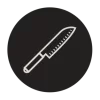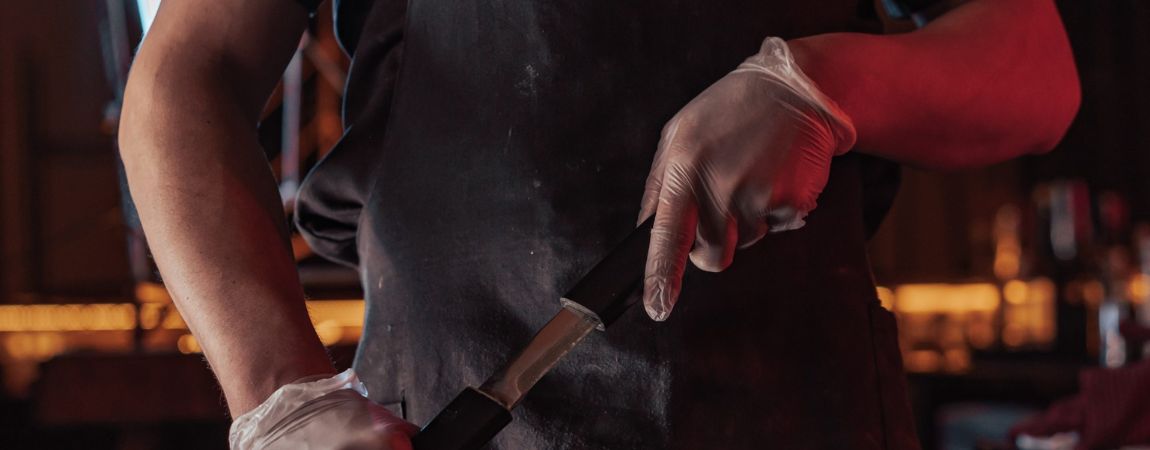Learning how to prepare delicious cuts of meat is one of the most rewarding processes one can go through. Whether you’re just starting to grow your collection or are a seasoned pro at this point, you’ll need a decent boning knife to get the job done. The question is, which knife should you go for? This article will explore the curved VS straight boning knife debate.
We’ll cover what boning knives work well for, what makes each type of boning knife stick out, and how to make a decision that works for you and your kitchen.
What is a Boning Knife?
If you’re reading this article, you’re probably au fait with kitchen tools already, but we’ll briefly explain boning knives here in case you’re a budding knife aficionado.
If you’re separating raw meat from the bone, you’ll probably need a boning knife. They’re typically quite flexible and thin with a sharp point to make it easier to pierce the flesh and cut through ligaments and other connective tissue. A decent boning knife doesn’t have to be expensive and it’s well worth the investment in our opinion.
The main two types of knives in this category are straight and curved. We explore the differences between curved VS straight boning knives below.
Straight Boning Knife Overview
As the name suggests, straight boning knives feature a straight, thin, and typically quite sharp blade. While they’re often a bit more flexible than a regular chef knife, they’re more rigid than their curved counterparts.
This will either be a boon or a burden depending on your specific use case. Read on to discover which applies to your collection.
Sharpness
The advantage of using a less flexible blade is that you’ll typically have a sharper knife at your disposal. For tougher or thicker cuts of meat, this can be a real Godsend. If sharpness is a priority for you, a straight boning knife is probably worth considering.
If you’re brand-new to deboning cuts of meat, there’s one thing to be ready for with a straight boning knife – meat wastage. The less forgiving blade can cut a bit inaccurately at first. Don’t worry too much though – you’ll be up to speed in no time.
Sharpening
Another bonus when using a straight boning knife is that they’re usually pretty straightforward to sharpen. With a straight blade, you won’t have to worry too much about getting the right angle or maintaining the edge you’re looking for.
With curved boning knives, this can be a little trickier.
Piercing Action
A mark of a good boning knife is how well it pierces into thicker cuts of meat. With a high-quality straight boning knife, you should be able to pierce, cut, and partition off meat to your heart’s content. While curved boning knives are fantastic in the right context, straighter options are usually better at making those first few incisions.
Tough and Precise Cuts
When you increase the sharpness of a blade, you increase the ease with which you’re able to slice through meat. If you’re preparing tougher cuts like beef, pork, or lamb, a straight boning knife might be a safe bet for you. They’re typically much better at this kind of work.
Provided you’re cutting with straight lines, this kind of boning knife can also be much more precise. If you have the requisite skills that is.
Uses for Straight Boning Knives:
- Pork and lamb filets.
- Beef filets and similar cuts.
- Deboning tougher meat.
- Piercing and deboning thick cuts of meat.
- Sectioning thicker meat into smaller cuts.
- Tackling thicker fat and ligaments.
Straight Boning Knives Basic Stats:
- Thickness: between 1.7 and 2.7mm
- HRC: 56-59.
- Length: between 5 and 8 inches.
Curved Boning Knife Overview
As you probably guessed, curved boning knives feature a curved blade and slightly more flexibility than straight boning knives. This means that the average sharpness and HRC on offer is likely to be lower, but this is far from a bad thing in the right context.
When deboning certain cuts of meat and seafood, you actually need some flexibility to be able to reach those tricky corners and cut through those stubborn pockets of fat. For this reason, curved boning knives are loved by pro chefs around the world. The good news is there are tons of options out there to add to your toolkit.
Tricky Cuts
If you’re working with poultry, fish, or seafood, a curved carving knife is probably the way to go. A curved blade with a bit of flexibility makes it much easier to prepare cuts of meat without damaging them. This is particularly noticeable with more delicate seafood.
Delicate Prep Work
With a bit of skill and a curved boning knife, you’ll never bruise or damage your filets again. Removing the bones from delicate fish calls for the accessibility and accuracy that comes with this kind of kitchen tool.
Sharpening
One thing to keep in mind with curved boning knives is that they can be a touch trickier to sharpen than their straight counterparts. Don’t get us wrong – it’s not rocket science to keep a curved knife sharp. It just takes a bit more patience and the right tools.
Depending on the angle and direction of your blade’s curve, a round-edge sharpening tool may help.
Uses for Curved Boning Knives:
- Preparing poultry.
- Fileting fish.
- Working with seafood and delicate cuts of meat.
- Deboning tasks that require flexibility.
Curved Boning Knives Basic Stats:
- Thickness: 1.8 – 2.6mm.
- HRC: 55-58.
- Length: between 5 and 8 inches.
Curved VS Straight Boning Knives – How They’re Different
In a nutshell, curved boning knives are more flexible and make it easier to prepare fish, seafood, and poultry. They’re a bit less sharp but can be more forgiving as a result.
In a nutshell, straight boning knives are sharper and therefore great for tougher cuts, beef, and pork. They’re better at piercing and slicing through more stubborn ligaments but can waste a bit more meat as a result.
| Knife | Curved | Straight |
| Blade Length | 5-8 inches | 5-8 inches |
| Blade Thickness | 1.8-2.6mm | 1.7-2.7mm |
| Flexibility | Some, more than straight boning knives. | Some, but less than curved boning knives. |
| HRC | 55-58 | 56-59 |
| Sharpening | A little challenging, use a curved-edge stone or manufacturer’s guidance. | Fairly straightforward. |
| Main Purpose | Poultry, fish, seafood, delicate deboning. | Thick meats, pork, beef, straight, precise cuts. |
Curved VS Straight Boning Knives – How to Choose
Do you prioritize sharpness and mostly need to make straight cuts with precision? Need something to prep your beef, pork, and other thick cuts of meat? We recommend picking up a straight boning knife.
Need something with a bit more flexibility for poultry, fish, seafood, and other delicate cuts? A curved option should suit you well.
Straight Boning Knife Recommendation
We absolutely love this straight boning knife:
– Victorinox Fibrox Pro 6” Boning Knife

It offers a phenomenal performance-to-price ratio.
Curved Boning Knife Recommendation
This curved boning knife won’t let you down:
– Wusthof Classic 5” Boning Knife

It has everything you need to prep like a pro and will look fantastic in your kitchen.
You might be interested >> Boning knifes vs fillet knives
Recap
If you can afford it, we actually recommend picking up both a curved and a straight boning knife. Each tool shines brightest in pretty different contexts, so you’re unlikely to regret your decision.
Your straight boning knife will tackle your tougher meats and your curved boning knife will deal with the trickier, more delicate jobs.




Post Your Thoughts